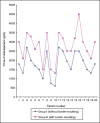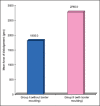Comparative analysis of the retention of maxillary denture base with and without border molding using zinc oxide eugenol impression paste
- PMID: 27134447
- PMCID: PMC4836091
- DOI: 10.4103/0975-962X.179380
Comparative analysis of the retention of maxillary denture base with and without border molding using zinc oxide eugenol impression paste
Abstract
Aims and objectives: The purpose of the study was to determine the effect of border molding on the retention of the maxillary denture base.
Materials and methods: Two special trays, one with full extensions to the periphery and one 2 mm short from the borders were made on the cast obtained from the preliminary impression. Border molding was done on the tray which was short from borders. On both trays, the final impression was made with zinc oxide eugenol impression paste. Heat cure denture bases were fabricated on the prepared casts and retention was measured using specially designed instrument.
Observations and results: Mean force with border molding (2765.0 g) was larger than mean force without border molding (1805.0 g) at P < 0.01 level. In terms of percentage, too, the mean improvement (59.4%) in force of dislodgement was statistically highly significant (i.e. P < 0.01).
Clinical significance: The results of the present study suggest that the dentures made with border molding will provide better retentive force than the dentures made without border molding.
Keywords: Border molding; peripheral seal; retention.
Conflict of interest statement
Figures








Similar articles
-
Evaluation and Comparison of the Effect of Different Border Molding Materials on Complete Denture Retention: An in vivo Study.J Contemp Dent Pract. 2018 Aug 1;19(8):982-987. J Contemp Dent Pract. 2018. PMID: 30150501
-
In vivo evaluation of the impact of various border molding materials and techniques on the retention of complete maxillary dentures.Dent Med Probl. 2020 Apr-Jun;57(2):191-196. doi: 10.17219/dmp/115104. Dent Med Probl. 2020. PMID: 32649808
-
Comparative evaluation of border molding, using two different techniques in maxillary edentulous arches - An in vivo study.J Int Oral Health. 2013 Dec;5(6):82-7. Epub 2013 Dec 26. J Int Oral Health. 2013. PMID: 24453450 Free PMC article.
-
A comparative clinical trial for evaluating the posterior palatal seal developed from the conventional method and a novel functional swallow method.J Indian Prosthodont Soc. 2022 Jan-Mar;22(1):21-28. doi: 10.4103/jips.jips_235_21. J Indian Prosthodont Soc. 2022. PMID: 36510944 Free PMC article. Clinical Trial.
-
Complete Denture - Border Molding Technique Using a Laboratory Condensation Silicone Putty: Review.Prague Med Rep. 2023;124(4):359-379. doi: 10.14712/23362936.2023.28. Prague Med Rep. 2023. PMID: 38069643 Review.
Cited by
-
Misfit of Complete Maxillary Dentures' Posterior Palatal Seal following Polymerisation with Four Different Autopolymerising Resins: An In Vitro Study.Materials (Basel). 2022 Jul 30;15(15):5285. doi: 10.3390/ma15155285. Materials (Basel). 2022. PMID: 35955220 Free PMC article.
-
Evaluation of open-face maxillary complete denture for patients with prominent premaxilla: a crossover study.BMC Oral Health. 2024 Apr 19;24(1):473. doi: 10.1186/s12903-024-04231-8. BMC Oral Health. 2024. PMID: 38641783 Free PMC article.
-
THE EFFECT OF RIDGE HEIGHT ON RETENTION OF ACRYLIC AND FLEXIBLE DENTURES IN PATIENTS WITH COMPLETE EDENTULOUS MAXILLARY ARCH: A PILOT STUDY.Ann Ib Postgrad Med. 2022 Dec;20(2):151-159. Ann Ib Postgrad Med. 2022. PMID: 37384340 Free PMC article.
-
Measuring the retention of removable mandibular prostheses by a standardized model: A technical report.J Indian Prosthodont Soc. 2019 Jul-Sep;19(3):272-275. doi: 10.4103/jips.jips_173_19. J Indian Prosthodont Soc. 2019. PMID: 31462868 Free PMC article.
-
To Study the Effect of Anterior Palatal Surface Modifications of Complete Denture on Speech Intelligibility Oral Perception and Cortical Brain Function Activity: An In Vivo Study.Cureus. 2023 Jan 10;15(1):e33595. doi: 10.7759/cureus.33595. eCollection 2023 Jan. Cureus. 2023. Retraction in: Cureus. 2023 May 18;15(5):r71. doi: 10.7759/cureus.r71. PMID: 36779152 Free PMC article. Retracted.
References
-
- The glossary of prosthodontic terms. J Prosthet Dent. 1999;81:56. - PubMed
-
- Schlosser RO. 2nd ed. Philadelphia: WB Saunders Co; 1946. Complete Denture Prosthesis; pp. 58–9.
-
- Landa JS. New York: Dental Items of Interest Publishing Company, Inc; 1947. Practical Full Denture Prosthesis. - PubMed
-
- Skinner EW, Campbell RL, Chung P. A clinical study of the forces required to dislodge maxillary denture bases of various designs. J Am Dent Assoc. 1953;47:671–80. - PubMed
-
- Gehl DH, Dreson OM, Barone JV. Physiologic complete denture impressions. J Prosthet Dent. 1963;13:800.
LinkOut - more resources
Full Text Sources
Other Literature Sources
Miscellaneous
